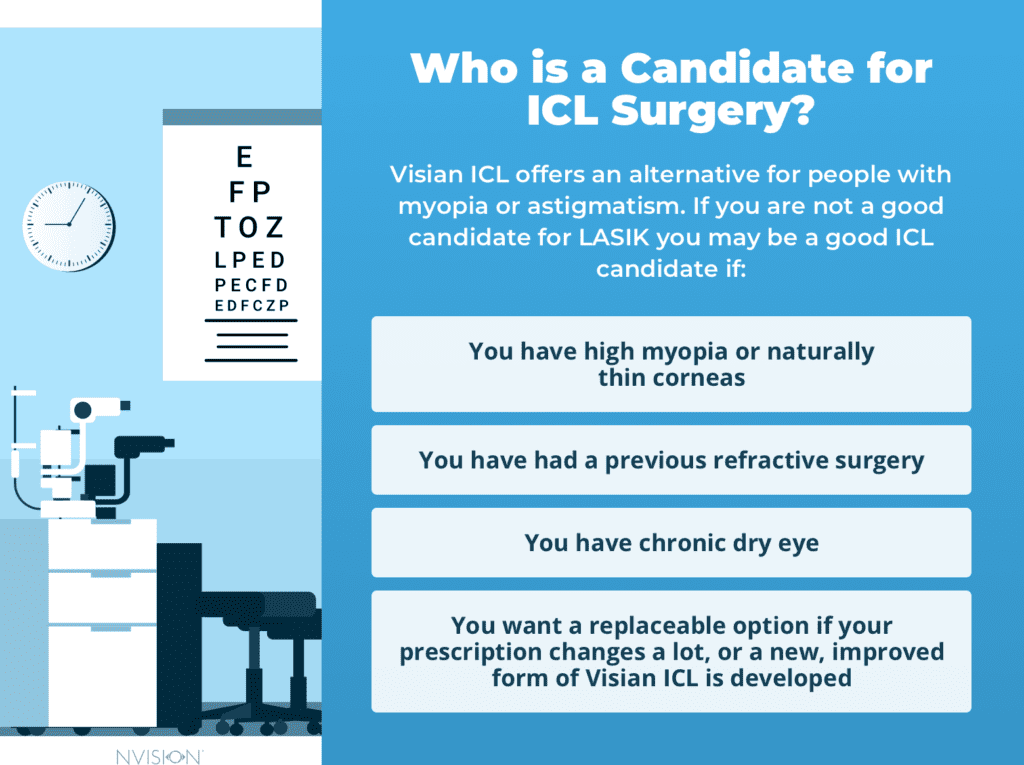
Medically Reviewed by Tom Tooma, M.D., Founder/Medical Director NVISION Surgeon
ICL Surgery: Costs, Side Effects & What to Expect
Last Updated:

Medically Reviewed by Tom Tooma, M.D., Founder/Medical Director NVISION Surgeon
ICLs are like implantable contact lenses that improve visual acuity, or eyesight, for people who have myopia, astigmatism, or both.
Table of Contents
Many adults with stable refractive errors can benefit from ICLs, especially if they are not good candidates for LASIK for certain reasons. Clinical studies have also shown this implantable lens option is a safe, effective procedure to improve vision.
The Visian ICL surgery is like LASIK or other refractive surgeries, although it is slightly more invasive, requires a few more steps in the weeks leading up to it, and takes about 10 minutes longer in the operating room. As with every surgery, there are some risks to Visian ICL surgery, and it costs a bit more than a procedure like LASIK.
Visian ICLs can be replaced if needed, and the surgery comes with the potential for few long-term side effects.
Visian Implantable Collamer Lenses (ICLs): An Alternative to LASIK

Visian Implantable Collamer Lenses (ICLs) are like permanent contact lenses. These miniscule artificial lenses are implanted within the eye to improve vision for people with myopia, or nearsightedness.
Myopia is the most common vision problem in the world, and its prevalence appears to be on the rise. A 2016 study using data from the American Academy of Ophthalmology (AAO) reported that 9.6 million adults in the United States alone are severely myopic. The study also found that the percent of the population with myopia has risen — from 25 percent in 1970 to 40 percent of the population around 2000.
You deserve clear vision. We can help.
With 135+ locations and over 2.5 million procedures performed, our board-certified eye surgeons deliver results you can trust.
Your journey to better vision starts here.
For centuries, humans have corrected their blurry vision with glasses. In the 20th century, contact lenses became inexpensive, easy to produce, and safe, when used with appropriate cleaning habits.
But many people desired to correct their myopia surgically. Laser in-situ keratomileusis (LASIK) has been one of the most popular solutions, but not everyone is a good candidate for that surgery. ICLs present an alternative to removing corneal tissue from your eye.

Who Benefits Most From Visian ICLs?
Visian ICLs can be a good option for many people who have myopia or astigmatism. These small devices are small artificial lens implanted in the eye to improve vision.
Until recently, most people who received artificial lenses had undergone cataract surgery, so the natural, clouded lens in their eye was removed and then replaced with a synthetic lens. However, a modified artificial lens called an ICL can be implanted in the eye to work in concert with your natural lens, allowing you to see more clearly and get you out of glasses and contact lenses.
The Visian ICL is implanted behind the iris, but in front of the natural lens. Adding an additional lens helps focus light without removing any tissue from your cornea, as in LASIK surgery. These lenses work best in people who:
- Have a stable refractive error, or no change of more than 0.5 diopters in the past year.
- Have myopia ranging from -3.0 to -16.0 diopters, with 4.0 diopters or less of astigmatism.
- Reducing myopia from -15.0 to -20.0 diopters.
- Are between 21 and 45 years old.
- Are not good candidates for LASIK due to personal preference or cornea thickness.
While LASIK offers treatment for a wide range of refractive errors, ICLs are intended only for people who have myopia. The lenses treat a specific range of myopia. ICLs are not approved to treat farsightedness, either hyperopia or age-related presbyopia.
As of 2018, about 9.5 million people in the U.S. have had LASIK. Though rare, lasik can lead to certain side effects. While side effects tend to go away within six months, they can be annoying during that time.
Visian ICL offers an alternative for people with myopia or astigmatism. You may be a poor candidate for LASIK but a good ICL candidate if:
- You have high myopia or naturally thin corneas.
- You have had a previous refractive surgery.
- You have chronic dry eye, which can get worse from LASIK surgery.
- You want a replaceable option if your prescription changes a lot, or a new, improved form of Visian ICL is developed.
Clinical Studies Show Visian ICLs Work Well

Clinical studies report that ICLs offer a good option to improve myopia or astigmatism, just like LASIK. One of the first studies of these lenses involving 210 participants, 124 of whom received Visian ICLs, found that 97.4 percent achieved improved visual acuity to within 1.0 diopter of their targeted refraction, or just shy of 20/20 vision. Almost 98 percent of the participants experienced 10 degrees or less of lens rotation within a year, so their vision did not change significantly.
Lens rotation was the most common side effect, which rarely occurred to any significant, sight-changing extent. Participants who did develop this problem underwent a second surgery to reposition, remove, or replace the lens. The clinical trial found that there was no significant loss of vision sharpness after the lens was replaced or repositioned.
A new study following 83 participants for five years, who received newer ICLs to treat higher myopia found that 95 percent of the eyes had 20/25 vision or better after ICL surgery. After five years, many of these participants had worsened visual acuity, but this was due to their natural myopia progression.
Data suggests that Visian ICLs are a great option for people who have myopia, astigmatism, or both, to improve their vision without losing any tissue from their cornea.
You deserve clear vision. We can help.
With 135+ locations and over 2.5 million procedures performed, our board-certified eye surgeons deliver results you can trust.
Your journey to better vision starts here.
The Visian ICL Surgical Procedure
Like any vision surgery, the Visian ICL surgery requires a complete eye exam and consultation with an optometrist or ophthalmologist. This ensures your eyes are healthy, you have no underlying conditions that would complicate the procedure, and your refractive error is within the ICL specifications.
You should also discuss any medications you take that are not involved directly in your vision. Underlying health conditions and some medications can impact your overall healing time.
Your eye surgeon may ask you to stop wearing contact lenses for two to four weeks prior to the exam. Even soft contact lenses have an impact on the shape of your cornea and your eye prescription. Giving your eyes time to reshape ensures your eye doctor gets a stable measurement of your prescription.
Arrange transportation to and from the procedure. While the Visian ICL surgery is an outpatient procedure, meaning you will go home the same day as the operation, you will not be able to drive yourself. Your doctor will tell you when your vision is good enough to drive again.
Here’s an overall timeline of what to expect:
- Two to three weeks before surgery: You will visit your eye doctor to obtain measurements of your prescription and eye so that your surgeon can order the customized ICL for your eye.
- Day of surgery: You will receive numbing eye drops. Then, you’ll lie down and your surgeon will place an eyelid holder in your eye to keep your eyelids open. A small incision will be made in your cornea, which is the clear structure at the front of your eye. Finally, your eye surgeon will implant the Visian ICL.
The entire operation takes between 20 and 30 minutes, which is slightly longer than LASIK. You will receive medicated eye drops, and your surgeon may put a patch over your eye to protect it until the day after the procedure. You may need to wear a patch or shield for several days or weeks after the operation at night or while you shower, to ensure you do not scratch your eye or get anything inside it. This helps to prevent any infection or damage to the eye.
Your eye doctor will examine your eyes the day after the procedure.
Costs, Risks & Recovery From Visian ICL Surgery

Visian ICLs are a great option for many people, but they do cost more than LASIK. Reported prices can range from $1,500 to $5,000 per eye, depending on where you live, your eye surgeon’s experience, and other factors.
ICLs are considered cosmetic, and they are not going to be covered by your vision insurance, so the cost is out of pocket.
As with any surgery, there are potential side effects and risks associated with ICL surgery:
- Infection (endophthalmitis).
- Undercorrection or overcorrection that requires another operation to correct the issue.
- Inflammation of the eye.
- Bleeding into the eye.
- Halos, glares, or double vision.
- Macular edema.
- Damage to the cornea.
- Developing cataracts.
- Increased eye pressure, leading to glaucoma.
- Iris prolapse.
- Needing a second eye surgery to remove or replace the lens
If you develop high ocular pressure, you may require a surgical procedure to reduce that pressure. Iris prolapse may necessitate surgery too.
Visian ICLs & the Future of Refractive Correction
It is very rare for people who receive Visian ICLs to need another procedure to improve their vision.
In the rare case that your vision is not corrected to 20/40 or better, you may need glasses or contact lenses. It is possible to undergo a refractive laser surgery like LASIK to improve your vision further. Talk to your eye surgeon about this option.
Depending on the situation, you may not be able to get subsequent LASIK procedures, particularly if your cornea is too thin after one operation. While the ICL is not removable in the same way that soft or hard contact lenses are removable, the Visian ICL can be safely taken out and replaced with a new lens if needed to correct vision.
Overall, LASIK is a much more popular procedure than ICL surgery. If you don’t think LASIK is the right procedure for you, talk to your eye doctor about ICL surgery and other options. They can help you weigh the pros and cons to make the best decision.
You deserve clear vision. We can help.
With 135+ locations and over 2.5 million procedures performed, our board-certified eye surgeons deliver results you can trust.
Your journey to better vision starts here.
References
- About. Visian ICL.
- Nearly 10 Million Adults Found to Be Severely Nearsighted in the United States. (June 2016). American Academy of Ophthalmology (AAO).
- LASIK. (July 2018). United States Food and Drug Administration (FDA).
- Visian Toric ICL (Implantable Collamer Lens). (October 2018). United States Food and Drug Administration (FDA).
- Summary of Safety and Effectiveness Data (SSED): Phakic Toric Intraocular Lens (IOL), Visian ICL. (September 2018). United States Food and Drug Administration (FDA).
- Comparison of Implantable Collamer Lens Visian ICL V4 and ICL V4c for High Myopia. (June 2017). Medicine (Baltimore).
- Refractive Errors. (July 2019). National Eye Institute (NEI).
- Blurred Vision, Burning Eyes: This Is a LASIK Success? (June 2018). The New York Times.
- When Is LASIK Not for Me? (July 2018). United States Food and Drug Administration (FDA).
- New Implantable Collamer Lens Shows Good Safety Profile. (April 2019). American Academy of Ophthalmology (AAO).
- Facts You Need to Know About STAAR Surgical’s Visian Toric ICL SURGERY. (2017). United States Food and Drug Administration (FDA).

Dr. Tooma, the founder of NVISION® Eye Centers, has performed well over 130,000 LASIK surgeries, making him the most experienced LASIK surgeon in the Western United States.
This content is for informational purposes only. It may have been reviewed by a licensed physician, but is not intended to serve as a substitute for professional medical advice. Always consult your healthcare provider with any health concerns. For more, read our Privacy Policy and Editorial Policy.
